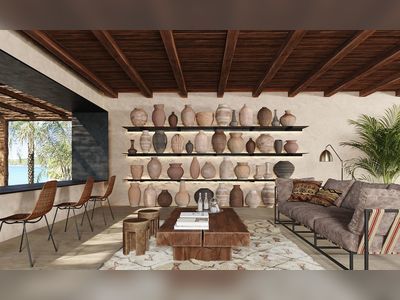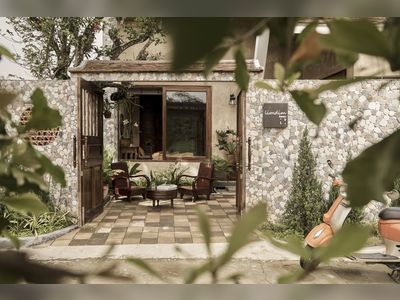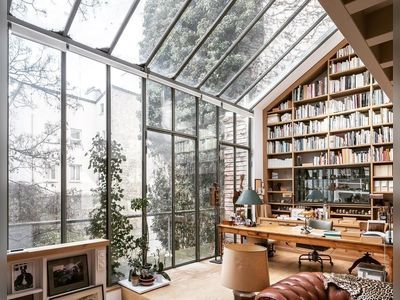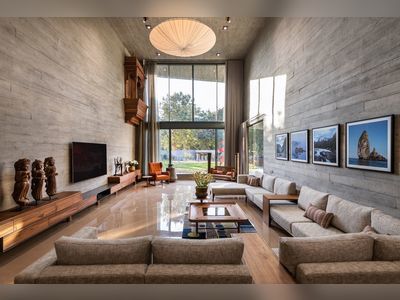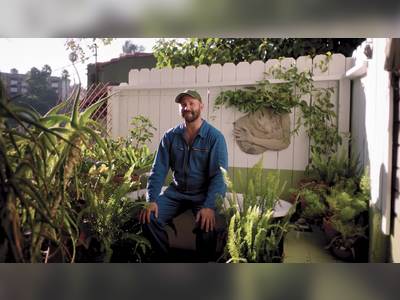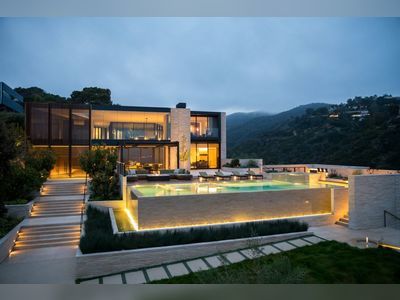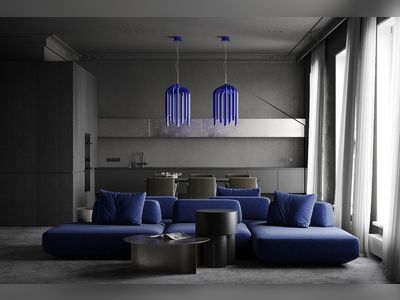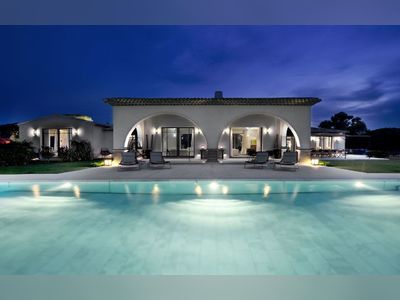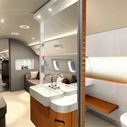
Bedroom area of an Embraer
ircraft, designed by Priestman Goode
Priestman Goode is a product design consultancy that has worked for many aircraft manufacturers and airlines in its time, including Airbus, Lufthansa, Virgin Atlantic and Indian operator Jet, as well as a few top-notch private-jet owners. What makes this company’s approach to interiors different from the norm is that it creates spaces as modules which fit together like giant pieces of architectural Lego. The interior features – the lighting, seating and functioning aspects – are integrated as they would be in an industrial product.
Product designers are fortunate to be involved in the early
stages of the design of these spaces before they have been realised. An
interior stylist has to work with the shapes, objects, walls, ceiling
and components that are already created. They’re always one step
behind. ‘We’re certainly not stylists and we’re not interior
decorators. A lot of people in the yacht and aircraft industries talk
about scatter cushions and fabrics, rather than designing the interior
with the manufacturers,’ observes Priestman Goode’s director Paul
Priestman.
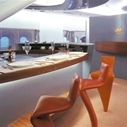
Bar area of an Airbus 380 aircraft,
designed by Priestman Goode
Priestman Goode’s project for Brazilian executive jet
manufacturer Embraer (where private jets cost about £50m) is a perfect
example.
Buyers can choose the layout of the aircraft’s interiors –
the number of bedrooms, the configuration of rooms. The modular
approach to
the design of the aircraft interior means that owners
can have it now, rather than wait years for components to be approved.
‘This means
you can certify all the different pieces of the modules,
and then when he client decides he wants a very big lounge or three
bedrooms it’s
already certified – which can normally take many
months and even years, depending on the complexity of changes. The
starting point in
its approach is to focus on how the space is used,
not just how it looks. The interiors are designed like giant products
in a giant space.
The modules are made inside a fake plane shell and
reassembled on board a real plane. If you’re working on something like
the superjumbo Airbus A380, that’s a seriously large space.
Priestman Goode has specialised in the build and assembly of
aircraft interiors, as well as the materials used. ‘We work very
closely with all the suppliers. A lot of this is honeycomb and there’s
a thin layer of material on top to make it look solid,’ Priestman
points out of the Embraer design. ‘We develop, and work closely with
suppliers to achieve something unique.’ There is certainly a lot of
room for improvement in aircraft interiors. Most planes take you past
the toilet and a few cupboards to get to your seat – it’s like entering
through the back door. ‘They’re like caravans – very detailed and
expensive caravans. We’ve tried to integrate things and make it feel
much more modern,’ says Priestman.
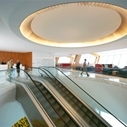
Quantas welcome lounge in
Sydney, designed by Marc
Newson
Aesthetics do come into it, but product designers are focusing more on tangible experiences. Often the results have a very clean, Stanley Kubrick-style, futuristic aesthetic. Expect a lot of white in this brave, new, pod-like world. Lighting is critical and used in many inventive ways – projected stars on to the ceilings, LEDs woven into the fabric of carpets and the seating or built into window panels. Lighting can change colour according to the time of day. The whiteness is also about brand identity. A plane may be built by Airbus, but it will be flying as Virgin or British Airways. Airbus retains a design identity, but the spaces can then be branded by airlines. It’s also about longevity. ‘Most of these aircraft are going to be flying for 20 years – you don’t want something to be overtly “now”,’ Priestman stresses. It is working on aircraft now that won’t be seen for another seven years. This is design for the future.
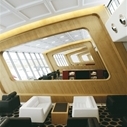
Quantas first class lounge,
designed by Marc Newson
The experience-focused approach is also something central to product design consultancy Tangerine. It began working with BA in 1998, designing the world’s first completely flat bed in business class. ‘The thought that [development] unlocked was about delivery freedom for passengers. Looking for new ways to unlock the space, rather than sit still in a reclining seat,’ explains Tangerine creative director Matt Round. By placing the seats in opposing directions, they were able to create the same number of flat beds in the same space as before. BA lost no space, and customers could move about in a more natural way. ‘It was about trying to make the experience the most important bit,’ Round says. ‘They were designed to create a much more informal and relaxed atmosphere, with a more domestic feel for global passengers. Planes occupy the space between office, home and hotel. We tried to capture all of those things and make that work within an aircraft interior.’ The designs were modular to allow easy repetition across different types and widths of aircraft.
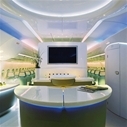
Airbus A350 cabin, showing the
TV screen and bar, designed by Priestman
Tangerine is also branching out into domestic interiors with the
same design approach. It is working on apartments with the South Korean
brand Rae Mi An – the domestic arm of the company that made the world’s
tallest building, Taipei 101. It has been consulting on the future of
domestic space, as well as creating products including the light
fittings. Although not modular, these flats will come in
different
grades, echoing the aircraft class system. In a natural development,
the move to reinvent aircraft interiors is spilling over into airport
lounges, as brands try to achieve a consistency in their experience and
aesthetic. Marc Newson, who has also worked on plane interiors, is
leading the way with his designs for Qantas’ lounges in Sydney and
Melbourne. Alongside the overall interiors, Newson created dozens of
bespoke products for the spaces, from the seating to the carpets. These
designs are described as being in the style of a super-luxury hotel,
complete with concierge service.
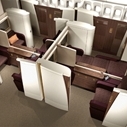
Aerial view of a jet interior,
designed by Priestman Goode
Product design has thus moved away from designing things in
isolation to designing things in specific environments. Today, you can’t
design
a cooker without designing a kitchen. The hotel analogy makes a
crossover seem logical here too – especially when using a modular
approach. Prefab spaces are cheaper to create and easy to install. But
this is modern prefab where aesthetics and integration of details are
everything. Priestman Goode’s designs for YoHotel aimed to create a
first-class experience in limited – and thus cheaper – space. It
treated corridors as aircraft aisles, complete with waitress service.
It avoided all superfluous decoration. ‘When you’re designing a product
or for an aircraft, you’re trying to do as many things as possible with
most components. Here you’ve got a bed that’s a sofa, that’s also a
double bed, but it’s all the same component,’ Priestman explains.
Entire walls were moulded in one piece, with the electrics in single
panels, to save on the fitting out. All the lighting was recessed,
saving money on light fittings. Everything was integrated into the
pod-like rooms.
The company has also worked with Accor and is consulting on a hotel
in the UK, where it is the controlling creative which hired the
architect. It recently won a big project with Motel 6 in the US,
creating modular hotel rooms. ‘We were up against three US architects.
We were the only Europeans and the only product designers,’ says
Priestman. ‘I think we were the real outsiders, but we got it with a
very simple idea.’ It’s also working on modular rooms for a 19-deck
cruise ship currently being built. Again, the limitations of the length
and width of the shell influenced the design. Although under wraps,
Priestman shows early designs of the rooms being created, like teardrop
or yin-and-yang shapes, to fill the space as densely as possible. All
this is a long way from the 20th-century Modernist model of a product
designer’s skill being based on the ability to create an iconic chair.
‘That’s completely outdated. What we are designing is the embodiment of
the brand,’ Priestman points out. ‘With all of these things, we’re
carving out something that’s unique so nobody can go
there – we are carving out niches.’
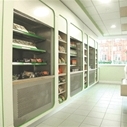
Interior of the eating area of an
Etap hotel, designed by Priestman Goode
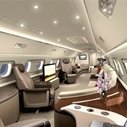
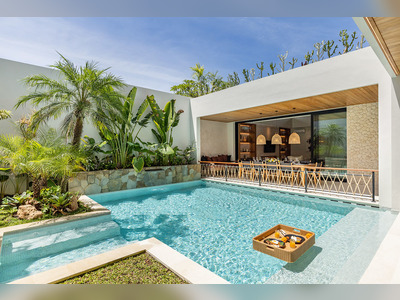
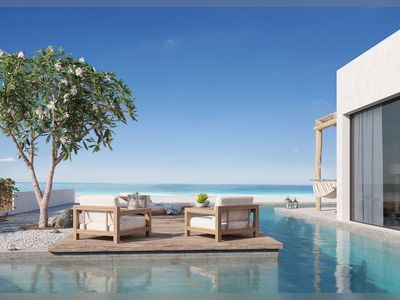
![A Tranquil Jungle House That Incorporates Japanese Ethos [Video]](/images/22/08/b-2ennetkmmnn_t.jpg)
